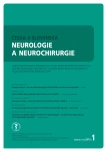New possibilities of ultrasound in predicting low back pain in adolescent males – pilot study
Authors:
R. Savickas 1; G. Krutulytė 1; D. Imbrasienė 2; V. Šiaučiūnaitė 3; I. Rimdeikienė 1
Authors‘ workplace:
Department of Rehabilitation, Medical Academy of Lithuanian University of Health Sciences Kauno klinikos, Kaunas, Lithuania
1; Lithuanian Sports University, Kaunas, Lithuania
2; Department of Mathematical Modelling, Kaunas University of Technology, Kaunas, Lithuania
3
Published in:
Cesk Slov Neurol N 2019; 82(1): 96-99
Category:
Short Communication
doi:
https://doi.org/10.14735/amcsnn201996
Overview
Aim:
To determine the possible relationship between low back pain (LBP) and asymmetry of the cross-sectional area of the multifidus spinal muscle as measured by US in physically active and inactive adolescent boys.
Materials and methods:
In total, 45 adolescent boys were examined – 28 boys were physically active and 17 physically inactive. Height, weight, occurrence of back pain were recorded, and the spinal multifidus cross-sectional area was measured by US. The results were listed as mean, standard deviation, and percentage change of results. The difference between two samples was deducted using a two-tailed Student t-test (the level of significance was p < 0.05).
Results:
The results showed that the multifidus muscle size was larger in the physically inactive group (4.86 ± 1.91 cm2) than the physically active group (4.06 ± 1.42 cm2). The non-significant asymmetry expressed as a percentage of the cross-sectional area of the multifidus spinal muscle was found between boys who were physically active and physically inactive with back pain: 17.7 (14.1–21.0)% and 10.9 (3.3–18.5)%, resp.; and also without back pain: 6.9 (6.6–7.4)% and 7.5 (6.9–8.0)%, resp.; but the significant asymmetry expressed as a percentage of the cross-sectional area of the multifidus spinal muscle was found between boys with back pain and boys without back pain in both the physically active (p < 0.05) and physically (p < 0.05) inactive groups.
Conclusion:
The pilot study showed that there might be a relationship between back pain and asymmetry of the cross-sectional area of the multifidus spinal muscle. Further studies are needed to confirm these results.
Keywords:
adolescent – low back pain – multifidus muscle
超声预测青少年男性腰痛的新可能性 - 试点研究
目标:
通过超声(US)测量身体活动和非活动青少年男孩的腰背痛(LBP)和多裂肌脊柱横截面积的不对称性之间的可能关系。
材料和方法:
共检查了45名青少年男孩 - 其中28名男孩身体活动,17名身体不活动。记录身高,体重和背痛的发生,并通过US测量脊柱多裂肌横截面积。结果列为平均值,标准偏差和结果的百分比变化。使用双尾学生t检验推断两个样品之间的差异(显着性水平p <0.05)。
结果:
结果显示,物理非活动组(4.86±1.91 cm2)的多裂肌大小比物理活动组(4.06±1.42 cm2)大。非显着性不对称表现为多裂肌脊柱肌横截面积的百分比,发现身体活动和身体不活动的男孩与背痛:17.7(14.1-21.0)%和10.9(3.3-18.5)%分别;并且没有背痛:分别为6.9(6.6-7.4)%和7.5(6.9-8.0)%;但在身体活动(p <0.05)和身体(p <0.05)非活动组中,发现背痛的男孩和没有背痛的男孩之间的多裂肌脊柱横截面积的显着不对称性表示为。
结论:
初步研究表明,背部疼痛与多裂肌脊柱横截面积的不对称性之间可能存在关联。需要进一步的研究来证实这些结果。
关键词:
青春期 - 腰痛 - 多裂肌
Sources
1. Roth-Isigkeit A, Thyen U, Stöven H et al. Pain among children and adolescents: restrictions in daily living and triggering factors. Pediatrics 2005; 115(2): 152–162. doi: 10.1542/ peds.2004-0682.
2. Jones GT, Macfarlane GJ. Epidemiology of low back pain in children and adolescents. Arch Dis Child 2005; 90(3): 312–316. doi: 10.1136/ adc.2004.056812.
3. Jones MA, Stratton G, Reilly T et al. Biological risk indicators for recurrent non-specific low back pain in adolescents. Br J Sports Med 2005; 39(3): 137–140.
4. Lafond D, Descarreaux M, Normand MC et al. Postural development in school children: a cross-sectional study. Chiropr Osteopat 2007; 15(1): 1–7. doi: 10.1186/ 1746-1340-5-1.
5. Shehab D, Al-Jarallah K, Al-Ghareeb F et al. Is low-back pain prevalent among Kuwaiti children and adolescents? A governorate-based study. Med Princ Pract 2004; 13(3): 142–146. doi: 10.1159/ 000076953.
6. Mikkelsson LO, Nupponen H, Kaprio J et al. Adolescent flexibility, endurance strength, and physical activity as predictors of adult tension neck, low back pain, and knee injury: a 25 year follow up study. Br J Sports Med 2006; 40(2): 107–113. doi: 10.1136/ bjsm.2004.017350.
7. Andersen BL, Wedderkopp N, Leboeuf-Yde C. Association between back pain and physical fitness in adolescents. Spine (Phila Pa) 2006; 31(15): 1740–1744. doi: 10.1097/ 01.brs.0000224186.68017.e0.
8. Boćkowski L, Sobaniec W, Kułak W et al. Low back pain in school-age children: risk factors, clinical features and diagnostic managment. Adv Med Sci 2007; 52 (Suppl 1): 221–223.
9. Krutulytė G, Valatkienė D, Samsonienė L et al. Evaluation of children age 11–12 posture according W. W. K. Hoeger visual method. Public Health 2007; 1(36): 16–20.
10. Hestbaek L, Leboeuf-Yde C, Kyvik KO. Are lifestyle-factors in adolescence predictors for adult low back pain? A cross-sectional and prospective study of young twins. BMC Musculoskelet Disord 2006; 7: 27. doi: 10.1186/ 1471-2474-7-27.
11. Steele E, Bialocerkowski A, Grimmer K. The postural effects of load carriage on young people – a systematic review. BMC Musculoskelet Disord 2003; 4: 12. doi: 10.1186/ 1471-2474-4-12.
12. Lee SW, Chan CK, Lam TS et al. Relationship between low back pain and lumbar multifidus size at different postures. Spine (Phila Pa) 2006; 31(19): 2258–2262. doi: 10.1097/ 01.brs.0000232807.76033.33.
13. Lieber RL. Skeletal muscle structure, function, and plasticity. 2nd ed. Baltimore, MD: Lippincott Williams & Wilkins 2002.
14. Magee D. Orthopedic physical assessment. 5th ed. Edmonton: Saunders Elsevier 2008: 6–7.
15. Ranger TA, Cicuttini FM, Jensen TS et al. Are the size and composition of the paraspinal muscles associated with low back pain? A systematic review. Spine J 2017; 17(11): 1729–1748. doi: 10.1016/ j.spinee.2017.07.002.
16. Hides JA, Stokes MJ, Saide M et al. Evidence of lumbar multifidus muscle wasting ipsilateral to symptoms in patients with acute/ subacute low back pain. Spine (Phila Pa) 1994; 19(2): 165–172.
Labels
Paediatric neurology Neurosurgery NeurologyArticle was published in
Czech and Slovak Neurology and Neurosurgery

2019 Issue 1
Most read in this issue
- Mild traumatic brain injury management – consensus statement of the Czech Neurological Society CMS JEP
- Chronic subdural haematoma
- Oligoclonal IgG and free light chains – comparison between agarose and polyacrylamide isoelectric focusing
- Ketogenic diet – effective treatment of childhood and adolescent epilepsies
